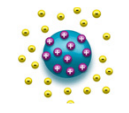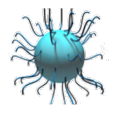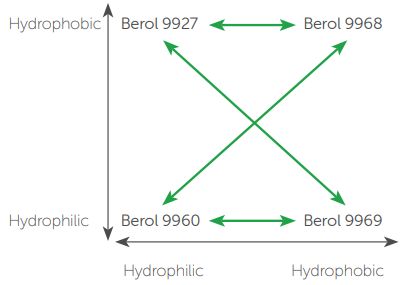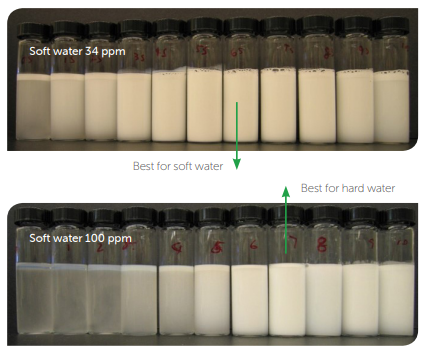Knowde Enhanced TDS
Identification & Functionality
- Chemical Family
- Agrochemical Functions
- CAS No.
- 8001-79-4
- Technologies
Features & Benefits
- Labeling Claims
- Agrochemicals Features
- Matched Pair of Emulsifier Blends
- The blend of emulsifiers includes anionic and nonionic surfactants in a balanced composition that brings ideal electrostatic and steric stabilization to the emulsion. In combination, as a matched pair, these four blends work for most pesticides and common solvents.
- Key Benefits
- Berol® 9968 is a nonionic / anionic emulsifier blends for standard aromatic solvent based EC formulations.
- The basic pair consists of Berol 9960 and Berol 9968. Depending on the HLB of the EC the emulsifier ratio needs to be determined by means of a ratio check. Berol 9927 and Berol 9969 can be used in more hydrophobic formulations.
- Robust – can be used with many active ingredients and solvents
- Tolerant to temperature and quality variations
- Convenient – easy to use and dose
- Effective at low concentrations
- Better hard water tolerance
- Reduced complexity and stock keeping
- Stabilization of Emulsions
Repulsive forces must be dominant for stable systems. Two mechanisms affecting dispersion stability:
- Electrostatic or charge stabilization - This is the effect on emulsified droplet interaction due to the distribution of charged species in the system

- Steric repulsion - This involves polymers adsorbing onto the surface and preventing the droplets coming into close contact. The thickness of the coating is sufficient to avoid van der Waals forces and flocculation

Applications & Uses
- Markets
Properties
- Formulation Type
- Physical Form
- Appearance
- Yellow brown liquid
- Dispersible in
- Water, Mineral oil
- Soluble in
- Xylene, White spirit, Octanol, Propanol, Solvesso 100, Soya bean oil, 80-85 arom cont, HAN, Solvesso 150, Solvesso 200, Kerosene, max. 2 arom cont
- Characteristics
- Specifications
| Value | Units | Test Method / Conditions | |
| Pour Point | 0 | °C | — |
| Surface Tension (according to Du Noüy at 25°C in 0.1%) | 28.2 | mN/m | DIN 53914 |
| Viscosity (at 20°C) | 900 | mPa.s | — |
| Wetting Power (according to Draves, at 20°C in 0.1%) | 8 | second | — |
| Value | Units | Test Method / Conditions | |
| Density (at 20°C) | 1010 | kg/m³ | — |
| Flash Point | 37 | °C | — |
| pH (1% in water) | 5 - 7 | — | — |
| Water Content | max. 0.5 | % | — |
Technical Details & Test Data
- Emulsifier Selection
Hydrophobic and hydrophilic components are designed to be tolerant to any variations in active ingredient quality by the means of making small adjustments.
To fit:
- Solvents
- Actives
- Concentrations
- Water hardness
- Temperature
Ensures:
- Low interfacial tension
- Good stability
- Spontaneous emulsion
- Small droplets



Packaging & Availability
- Country Availability
- Regional Availability

